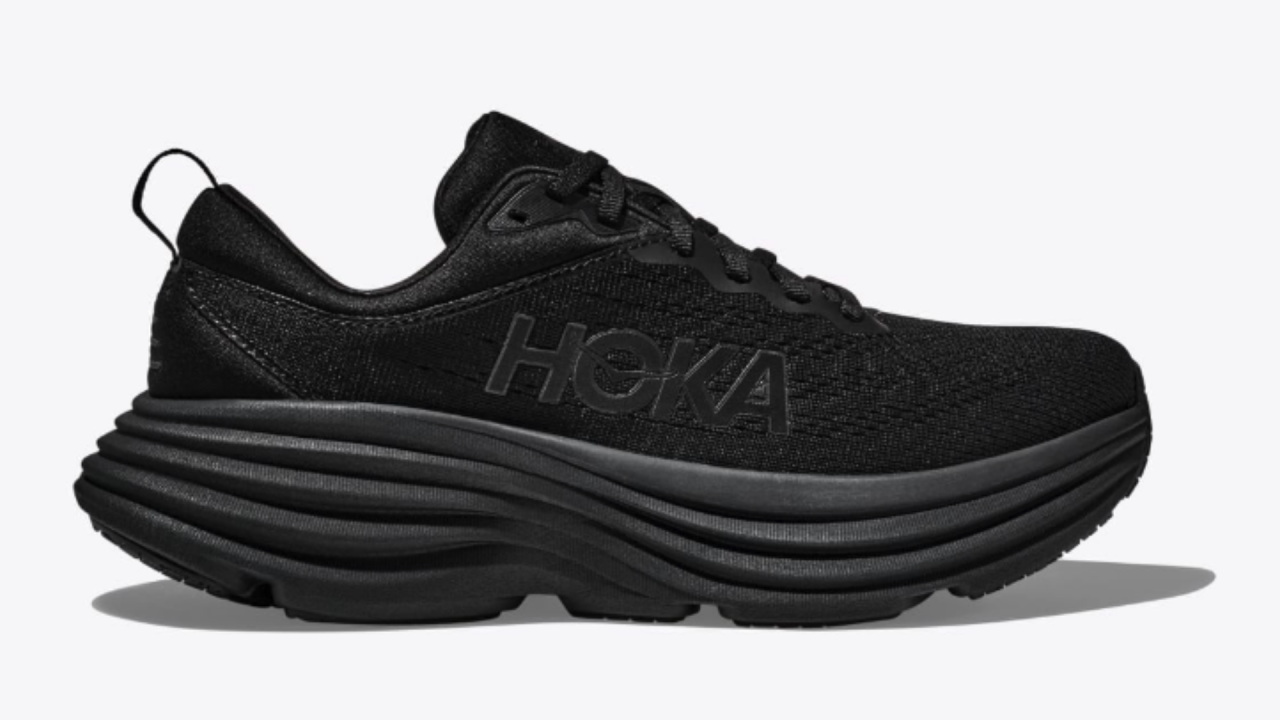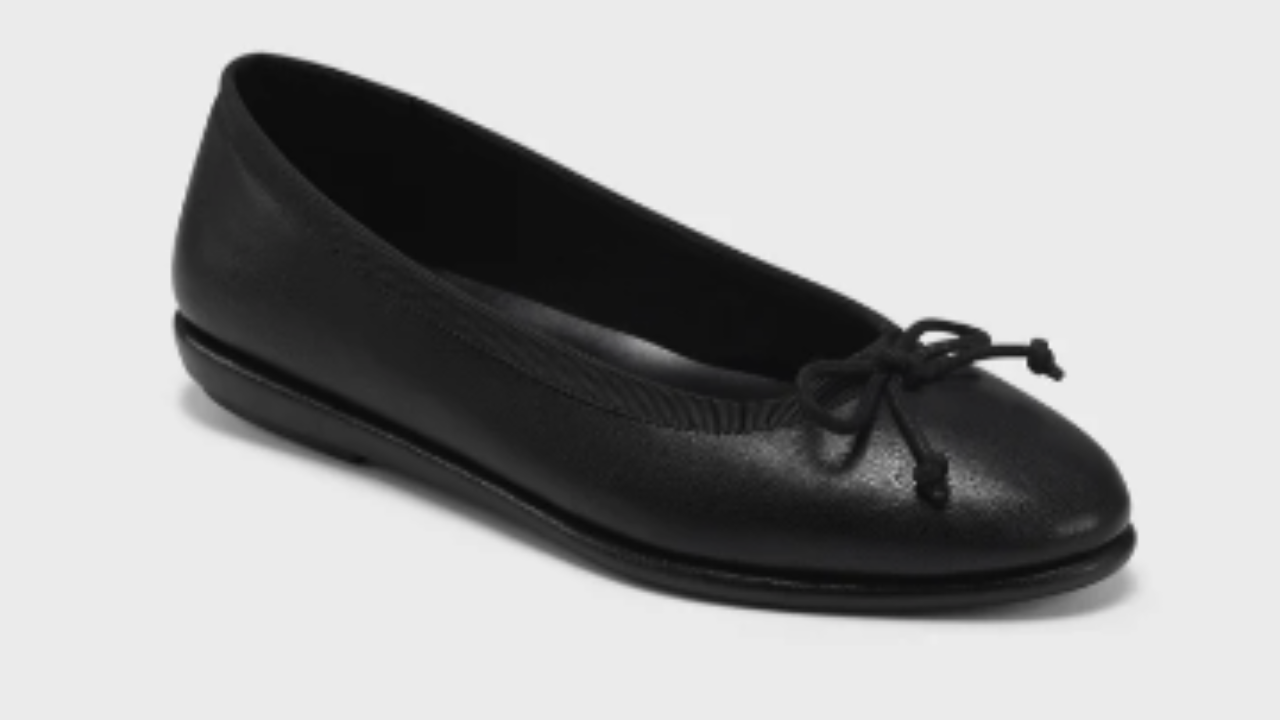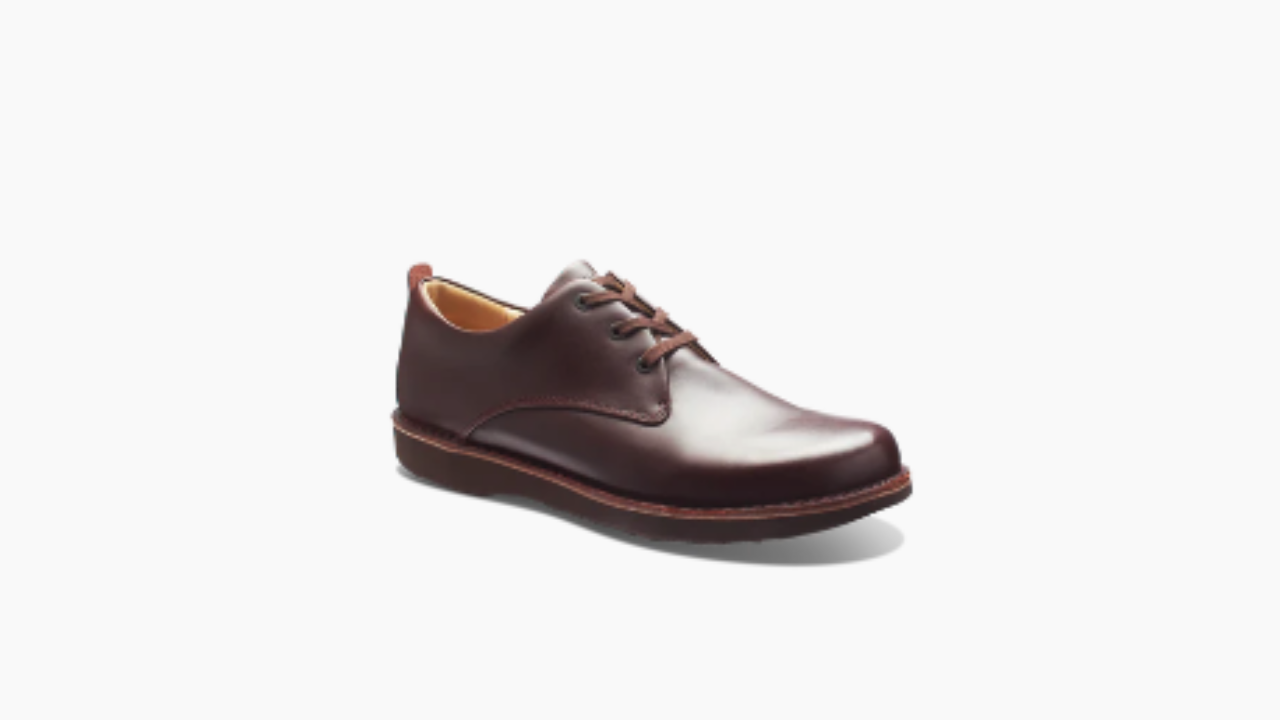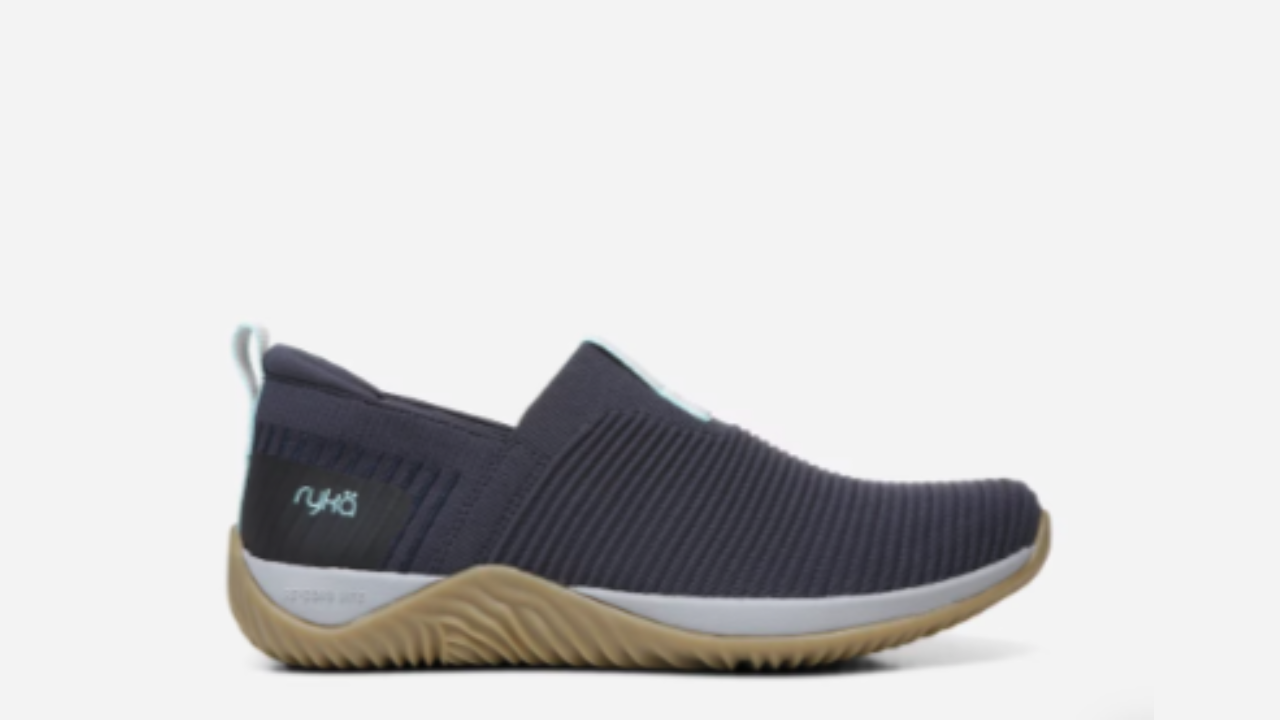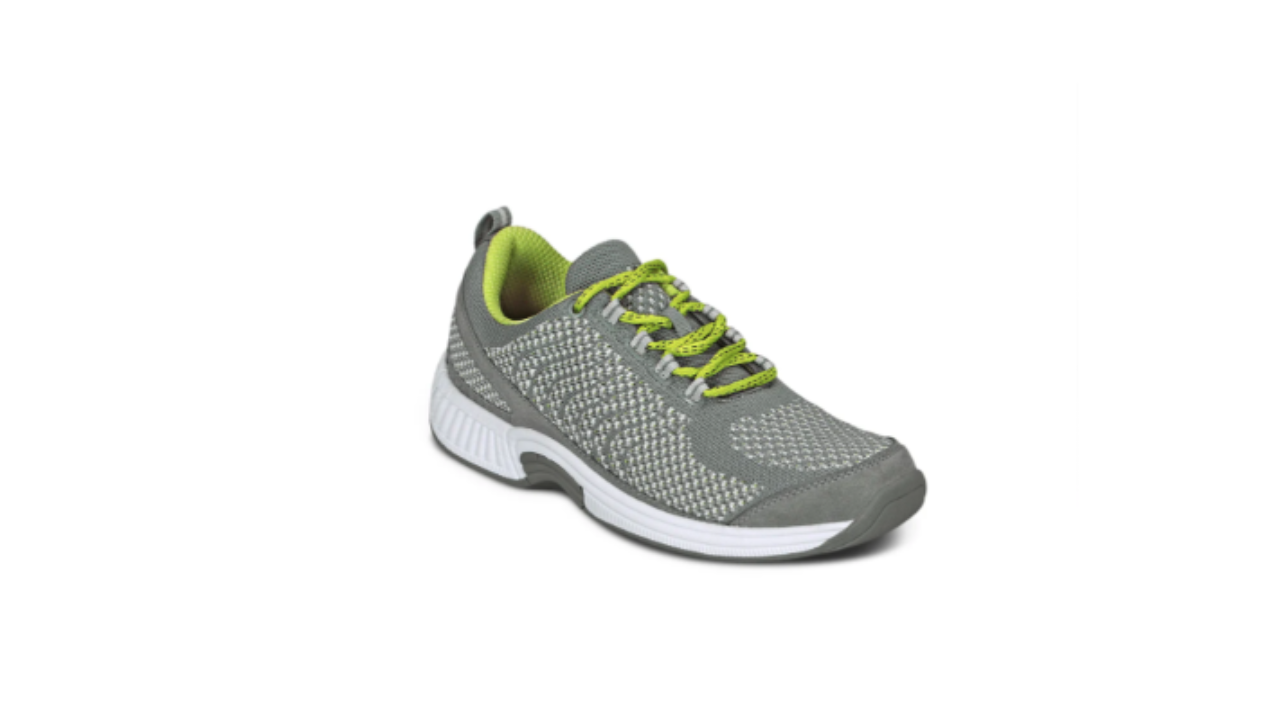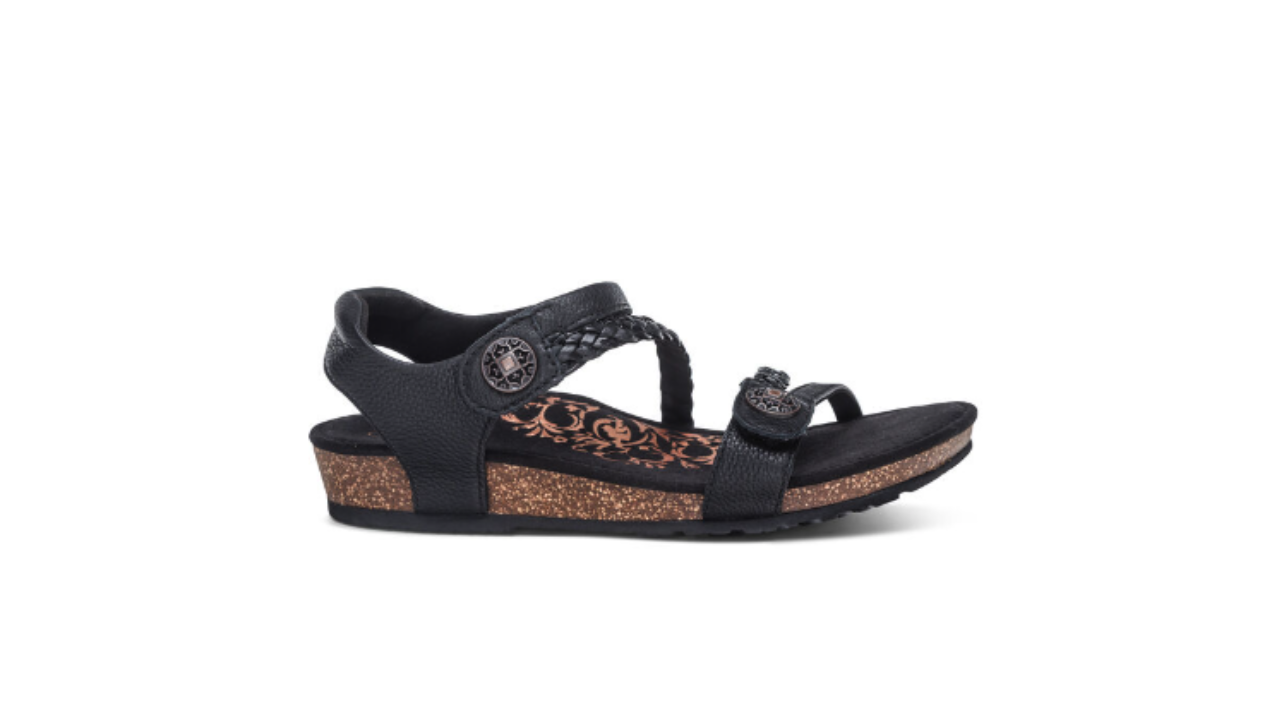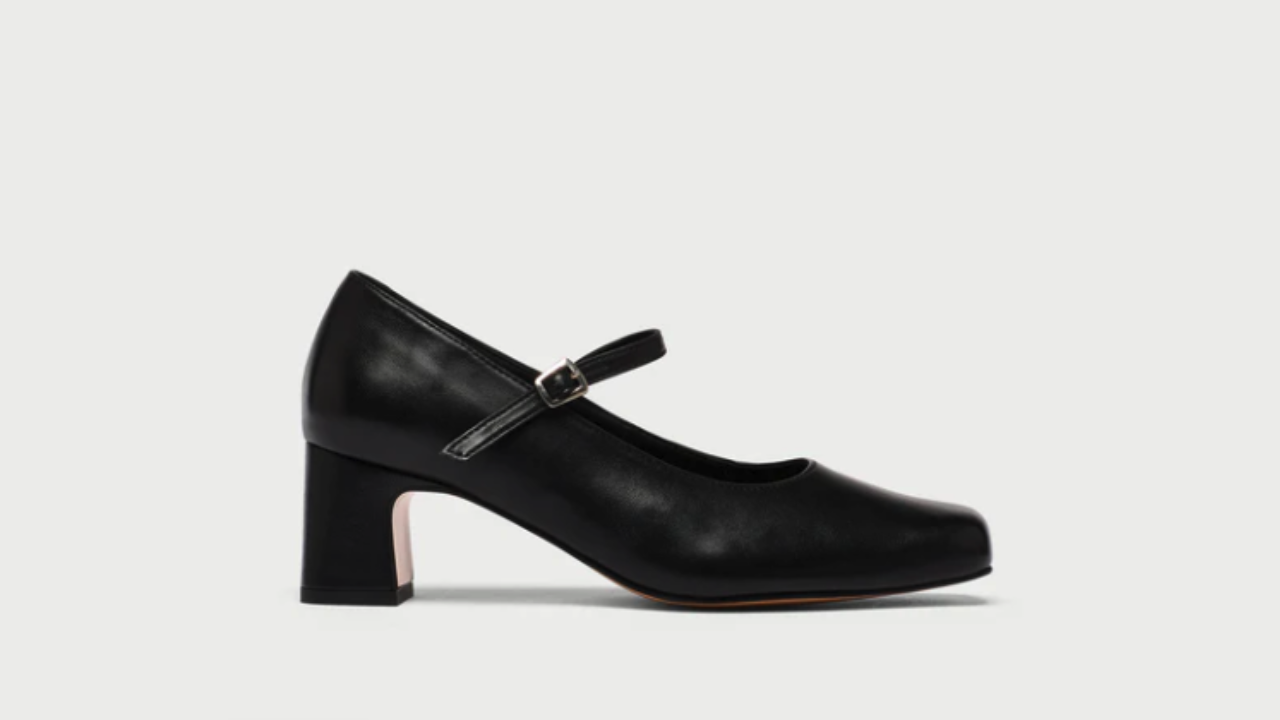We independently evaluate the products we review. When you buy via links on our site, we may receive compensation. Read more about how we vet products and deals.
The best shoes for flatfeet for 2024: Tested, reviewed and podiatrist-approved
Step up your shoe game with these top options from brands like Hoka, Aerosole and Ryka that give flatfeet the stability and support they need.
If you have flatfeet, you probably know how frustrating it can be to find the right footwear.
"Flatfeet, also known as pes planus, is a condition where the arches of the feet collapse, resulting in the entire sole coming into complete or near-complete contact with the ground," says Dr. Gregory Alvarez, a podiatry specialist at Ankle & Foot Centers of America in Georgia.
Hoka Bondi 8
Best overall shoe for flatfeet
Aerosole Homebet
Best ballet flat for flatfeet
Samuel Hubbard Hubbard Free
Best casual for men with flatfeet
Ryka Echo Knit Slip On Sneaker
Best budget sneaker for flatfeet
Saucony Guide 17
Best for mild to moderate over-pronation
OrthoFeet Coral Stretch Knit Sneaker
Best orthopedic sneaker for flatfeet
Klaw 528
Best walking shoe for flatfeet
Aetrex Jillian Braided Quarter Strap Sandal
Best sandals for women with flatfeet
Calla Mary Jane
Best heels for flatfeet
Although the condition is relatively common — one study suggests as many as 26% of adults are flat-footed — that doesn't mean it isn't without a few downsides. Namely, choosing and using the wrong footwear can contribute to increased foot pain or related issues because the arch isn't sufficiently supported. "In some cases, flatfeet can develop or be made worse by shoe choices," says Dr. Milica McDowell, an orthopedic physical therapist. Because of that, it's important to find supportive, functional footwear.
But that's easier said than done. You may not need orthopedic shoes (unless your podiatrist suggests them), but some of the most popular and trendy shoes don't offer the support and stability that flatfeet need. I should know — as a woman with flatfeet, I can attest to the struggle of finding shoes that are both cute and supportive.
Luckily, they do exist and we worked hard to find the absolute best options available. To find the best shoes for flatfeet, we first consulted with a panel of experts, including podiatrists, physical therapists and foot surgeons, to learn more about what to look for. We then evaluated over 50 different footwear companies and over 75 pairs of shoes, paying particular attention to the fit, arch support, width and sizes available, prioritizing shoes that are approved by the American Podiatric Medical Association (APMA). Finally, we tested our top selections to assess whether their claims truly made the cut. Keep reading to learn more about our top picks for best shoes for flatfeet.
Cost: $165 | Materials: EVA foam midsole, rubber outsole and mesh upper | Level of arch support: Neutral arch support | Sizes available: Women's 5-12 with half sizes up to 10.5; Men's 7-16 with half sizes up to 12.5 | Widths: Regular and wide
Hoka is one of the most popular footwear brands out there. While the company specializes in high-performance running shoes, it has gained mass appeal, becoming a favorite among celebrities, style enthusiasts and — most importantly — doctors.
Many of Hoka's shoes have earned the APMA Seal of Acceptance, which means they've been found to promote good foot health. For those with flatfeet, the brand's APMA-approved Bondi 8, a highly cushioned, neutral recovery shoe, is our top pick. Neutral shoes are most helpful for individuals who don't over-pronate or need added arch support as they're intended to allow the foot to move naturally through each step.
According to Jerick Sobie, co-owner of Lucky Feet Shoes and a trained pedorthist, Hokas are a good choice for those with flatfeet thanks to a few standout features, including their ultra-cushioned midsole and signature "meta-rocker" design. "Rocker bottoms make walking effortless," he says, since the style helps to lightly propel your steps in a forward motion. Research also suggests that rocker-soled shoes may be beneficial for those with Achilles tendinopathy, a condition common in those with flatfeet.
On top of their rocker-bottomed design, the Bondi 8 is Hoka's most cushioned shoe. And I can attest, the plush, EVA midsole not only makes it incredibly comfortable to wear, it's helped reduce my foot pain. Finally, although it's a neutral shoe, it has an extended heel and wider sole which works to provide plenty of stability.
- APMA approved
- Multiple colors, sizes and widths available
- Highly cushioned midsole
- Heavier than most running shoes
- May be too narrow for some
Cost: $69 | Materials: Faux leather upper and orthotic foam insole | Level of arch support: Neutral arch support | Sizes available: 5-12, with half sizes up to 10.5 | Widths: Medium and wide
Podiatrists generally agree that sneakers are the best option for those with flatfeet, but that's not always possible if you need something a bit more business casual for the office. That's where the Aerosoles Homebet ballet flat comes in.
Founded in 1987, Aerosoles is a women's footwear brand known for creating comfortable, practical shoes for everyday use. Like every pair of Aerosoles, the Homebet flats are made with comfort in mind, but they're also incredibly cute and stylish.
In terms of comfort, the flats feature orthotic foam insoles that provide ample cushioning and arch support. The material is lightweight and breathable too — I've worn them all day without worrying about sweaty feet.
As far as style goes, you can't go wrong with a chic, elegant ballet flat. The Homebet flats have a square shaped toe box, which I found to be roomier and more comfortable for my flatfeet. It also comes in medium and wide widths.
- Affordable price point
- Comfortable and stylish everyday shoe
- Offers orthotic arch support
- Not APMA approved
Cost: $235 | Materials: Leather uppers and lining, Vibram outsoles and triple-density insoles | Level of arch support: Neutral arch support | Sizes available: 7-14, with half sizes up to 11.5 | Widths: Medium, wide and extra wide
Since wearing sneakers with a suit isn't always appropriate, the Men's Hubbard Free is the next best thing for guys with flatfeet.
Samuel Hubbard may be a newer brand, but since the company's launch in 2014, it's managed to make a splash in the footwear scene. Handcrafted from high-quality materials and designed with comfort in mind, Samuel Hubbard is definitely a luxury choice, but one that's worth the cost.
All of the shoes have excellent arch support and many are APMA approved, including the Hubbard Free, also called the Men's Original Un-Sneaker. Thanks to its stylish appearance and comfortable feel, "un-sneaker" is a perfect description. At first glance, the Hubbard Free looks like your classic Oxford, with smooth leather uppers, a rounded toe and a lace-up closure. But unlike most dress shoes, our tester confirms this one feels more like a walking shoe. It features a roomy toe-box, heel-to-toe stability and triple-density, arch supporting insoles that can be removed for those who use custom orthotics.
The only real downside to this one is the price tag. At $235, it doesn't come cheap, but a truly comfortable, high-quality shoe is worth the cost.
- APMA approved
- Available in multiple sizes and widths
- Provides good stability
- Expensive
- Not water resistant
Cost: $70 | Materials: EVA foam midsole and rubber outsole | Level of arch support: Neutral arch support | Sizes available: Women's 5-11 with half sizes up to 9.5 | Widths: Medium and wide
The Echo Knit Slip On Sneaker from Ryka is our pick for the best budget sneaker for flatfeet.
Ryka is an athletic footwear brand designed specifically for women. Because the shoes are exclusively crafted for women's feet, they have a wider forefoot and narrower heel to maximize stability. Studies suggest that women may be more likely to have flatfeet than men, so choosing shoes designed for the structure of a woman's foot may offer the support you need to ward off foot pain.
Ryka's shoes also provide contoured cushioning based on the fact that women's hips tend to be wider than men's, so their weight is distributed differently across the foot during standing, walking and other activities. This women-specific cushioning maximizes support and comfort.
The Echo Knit is a lightweight, breathable slip-on sneaker that's comfortable for everyday wear and easy to take on and off. It's also APMA approved, so it comes recommended by podiatrists. Best of all, it's under $100.
- APMA approved
- Lightweight and breathable
- Roomy toe box
- Not much traction on wet surfaces
- Brand only offers shoes for women
Cost: $140 | Materials: Foam midsole and rubber outsole | Level of arch support: Stability shoe with medial arch support | Sizes available: Women's 5-12 with half sizes up to 11.5; Men's 7-16 with half sizes up to 12.5 | Widths: Regular and wide
According to board-certified podiatrist Dr. William Spielfogel, those with flatfeet should choose shoes with "good arch support, stability and cushioning to support the foot and prevent over-pronation."
Saucony's Guide 17 is a heavily cushioned, moderate guidance stability running shoe that's perfect for mild to moderate over-pronators. Stability shoes, contrary to neutral shoes, are specifically designed to help reduce over-pronation.
Pronation refers to the movement of your foot while walking or running. Over-pronation, which is common with flatfeet, means that your foot rolls too far inward. This has the potential to lead to problems, including shin splints, Achilles tendinitis and bunions, so podiatrists often recommend stability or motion control shoes, depending on the severity of the over-pronation. That said, not everyone with flatfeet over-pronates, but if you happen to fall into this category, a stability shoe is likely your best choice.
Stability shoes, like the Guide 17, feature additional support along the medial, or inner, side to help prevent over-pronation. One of the best things about the Guide 17 is how that support feels. In previous versions of the Guide, the shoe used a medial post, but in the latest version, the plastic post has been replaced by higher sidewalls and a wider platform. The result is a stability shoe that feels smoother and more natural. The Guide 17 also has far more cushioning, which I can attest makes it super plush and comfortable to wear.
However, it's worth noting that this is best for mild to moderate over-pronators. For those who have more serious over-pronation, the Saucony Omni might be a better fit.
- Roomy toe box
- Multiple colors available
- Provides lightweight and comfortable stability
- May not have enough stability for severe over-pronators
Cost: $100-$110 depending on color | Materials: Wool blend upper, foam midsole and rubber outsole | Level of arch support: Orthotic arch support | Sizes available: Women's 5-12 with half sizes up to 11.5 | Widths: Narrow, medium, wide and extra wide
Orthopedic shoes are specifically designed to provide support, comfort and pain relief for common foot problems. Orthofeet is an APMA-approved company that focuses exclusively on orthopedic footwear and orthotic inserts, which is why their Coral Stretch Knit Sneaker is our top pick for women with flatfeet who want an orthopedic shoe.
Part of what makes OrthoFeet shoes so different is how customizable they are, right out of the box. Every pair of shoes comes with a removable orthotic insole, arch booster and two fitting spacers for added volume and depth, so you can create the best fit for your needs.
Aside from those benefits, the Coral Stretch Knit Sneaker has a wide toe box, firm heel counter with extra cushioning and a mild rocker sole design, all of which can help provide more comfort, stability and pain relief.
It's worth noting that this particular style is only available for women, but there is a similar shoe for men — the Edgewater.
- Removable orthotic insole
- Available in four different widths
- Not water resistant
Cost: $148 | Materials: Leather upper, EVA foam midsole and rubber outsole | Level of arch support: Medial and lateral arch support | Sizes available: Women's 6-11 with half sizes up to 9.5; Men's 8-13 (no half sizes available) | Widths: Regular and wide
Let's be honest, the "ugly dad shoe" trend is here to stay. The style, characterized by a chunky, oversized silhouette, might be polarizing, but it's a supermodel staple that just so happens to be incredibly comfy. And our pick for best walking shoe — the Klaw 528 — is the epitome of an ugly-chic dad shoe.
Founded in 2022, Klaw may be a relatively young footwear company, but their first (and so far, only) sneaker has already gained massive popularity. The 528 is an ultra-cushioned walking shoe with a wide toe box, a deep heel cup and strong arch support. The removable insole has both medial and lateral arch support, so it provides impressive stability.
On top of that, the deep, highly cushioned heel cup provides more shock absorption, which can be especially beneficial for back and knee pain. According to one 2021 research study, flatfeet are frequently associated with lower back pain, so this sneaker is a good option for those seeking relief.
Full disclosure, when I first got the Klaw 528, they looked like huge, heavy clown shoes. But after actually wearing them, I can say they're by far the most comfortable, and surprisingly lightweight, sneakers I've ever worn. Since then, the minimalist, ugly-cool style has grown on me. They also happen to be water proof, so they're good for wearing even on rainy days.
They're available for men in white, yellow, gray and black and for women in white, gray, light blue, yellow, white and gray combo, light pink and black.
- APMA approved
- Removable insole
- Deep, cushioned heel cup
- Waterproof
- Polarizing style
- May be too wide for those with narrow feet
- High demand means many sizes and colors are wait-listed
Cost: $135 | Materials: Leather upper, memory foam and cork midsole, rubber outsole | Level of arch support: Neutral to moderate arch support | Sizes available: 5-12 with half sizes up to 10.5 | Widths: Standard only
Sneakers are generally the best option for people with flatfeet, but that can sometimes feel limiting — especially in the summer.
"For sandals, I recommend those with ankle straps," says Bruce Pinker, MD a board-certified podiatrist and foot surgeon. Specifically, he suggests brands like Vionic, Naot and Aetrex.
Sobie also recommends Aetrex, which is why our top pick is the brand's Jillian Braided Quarter Strap Sandal. "Aetrex shoes feature signature arch support, which helps with alignment and reduces issues like plantar fasciitis," Sobie says.
The Jillian Braided Quarter Strap Sandal also stands out thanks to its additional orthopedic features. It has bunion pockets, which are strategically placed straps to help relieve bunion pressure and pain, a padded heel to prevent blisters or irritation and a metatarsal pod on the bottom of the shoe to help ball-of-foot discomfort.
On top of that, the sandal is super cute thanks to the braided straps. I've paired mine with sundresses and jeans, and they look (and feel) great either way. This style also comes in 14 different colors (depending on the retailer) including bronze, ivory, rose and gunmetal.
- Adjustable straps
- Built-in arch support
- Designed to alleviate foot pain
- Only comes in standard width
- Expensive
Cost: $200 | Materials: Leather upper and lamb leather lining | Level of arch support: Mild arch support | Sizes available: 5-11 with half sizes up to 10.5 | Widths: Standard only
For those of us with flatfeet, wearing sky high, pencil-thin heels is basically a pipe dream. Not only is it more difficult to find a comfortable, wide-enough pair, but wearing heels strains the arch of the foot and places more stress on the ball of the foot.
As someone who enjoys getting dolled up now and then, I was determined to find a supportive, comfortable and stylish pair of heels for flatfeet. Luckily, I came across Calla, a luxury shoe company that specializes in footwear for bunions and wide feet. These shoes are wider at the toe box, but offer a standard-sized heel width, allowing for more natural movement at the ball of the feet and toes without sacrificing support at the heel.
The Mary Jane is especially comfortable for flatfeet. Most high heels leave your toes feeling squeezed, so the Mary Jane's roomy, square-shaped toe is a welcome relief. It also has a thicker, block heel, which provides far more stability than skinny-heeled options, like stilettos. I can also say that the cushy, supportive insoles make these the most comfortable pair of heels I've ever worn.
- Extra width in toe box
- Designed for bunions, foot pain and over-pronation
- Chic and stylish Mary Jane heel
- Expensive
- Only one width available
What to consider when buying shoes for flatfeet
Finding the right pair of shoes is a personal endeavor, so it will depend on your needs, wants, budget and overall preferences. However, if you have flatfeet, certain features may be more important to look for. Here are some of the factors to consider:
Arch support: Possibly the most important thing is to choose a shoe with good arch support. "Good arch support is essential as it helps evenly distribute your body weight across your foot, preventing pressure points and conditions like plantar fasciitis," says Brent Wells, a chiropractic physician. For people with flatfeet, arch support is especially beneficial, he says. "Look for footwear that either comes with built-in support or allows you to use custom orthotics."
Cushioning: A well-cushioned shoe is not only more comfortable to wear, it's a crucial part of maintaining good foot health. "Good cushioning absorbs shock and reduces the impact on joints, knees, hips and the lower back," says Wells. He recommends choosing a shoe with EVA or memory foam insoles and moderate or maximum cushioning.
Stability: Over-pronation is commonly seen in flatfooters, so look for a shoe with more stability, such as a larger and more rigid heel counter and a firmer midsole. McDowell recommends looking for a shoe with pronation control or a small medial post. "This will help lift up the inner arch, helping the foot to work with more neutral biomechanics," she explains.
Wide toe box: Shoes that are too tight in the forefoot area can cause various foot problems such as bunions, hammertoes or neuropathy. Choosing a shoe with a wider toe box is critical, particularly for those with flatfeet. "An ideal shoe should allow you to wiggle your toes while wearing them," McDowell says.
Heel features: Finally, pay attention to the height, comfort and stability of the heel. "Make sure that the shoe has a firm heel counter with a deepened heel cup," says Chirag Patel, a board-certified podiatrist. These features will help with over-pronation and heel pain. "Cushioning [at the heel] is also very important as it will help with shock absorption," he says.
How we chose the best shoes for flatfeet:
In order to find the best shoes for flatfeet, we consulted with a panel of footwear experts — podiatrists, physical therapists and orthopedic foot surgeons — for guidance on what to look for in a shoe. After that, we took their recommendations and insight into our own evaluations of more than 75 different shoes from popular footwear brands.
During our evaluation, we focused on arch support, stability features, fit, cushioning and materials used. We also considered cost, style and sizes available to determine our top picks. Finally, we prioritized APMA-approved shoes and doctor-recommended brands, ultimately testing all of the shoes we included on this list.
FAQs
How do I know if I have flatfeet?
It's usually fairly obvious to an observer when someone has flatfeet, but it can be harder to self-diagnose the condition. There are a few simple ways to tell.
According to Alvarez, one of the easiest ways to determine your arch shape is by doing what's known as the "wet test." The wet test is quick and can be done at home with very few materials.
"Wet the soles of your feet and then step onto a piece of paper," he explains. "If you see a complete footprint without any curve on the inner side, you likely have flatfeet."
Another at-home method is to simply use a mirror, says McDowell. Stand parallel to a mirror with the medial side of your foot (the big toe side) facing the mirror, she explains. Look at the medial side and note whether or not you can see an arch. "The less arch you see, the flatter the foot."
You can also look at a pair of shoes you wear frequently, says Dr. Patel. "Look for uneven wear patterns such as the inside sole of the shoe being more worn out."
Are flatfeet normal?
Arch shape can be classified in one of three ways: normal (neutral foot), high (cavus foot) and low (flatfoot).
"Flatfeet are relatively common and can be considered a normal variation of foot structure," says Alvarez. "However, they can lead to problems such as foot pain, particularly in the heel and arch, as well as issues with the ankles, knees, hips and lower back due to altered biomechanics."
Christynne Helfrich, a physical therapist, adds that some people with flatfeet don't experience any issues while others can develop injuries as a result. "Types of pain can include shin splints, plantar fasciitis and Achilles tendonitis as some of the tendons get irritated due to excessive rubbing from improper mechanics," she says.
What are the best shoes for flatfeet?
The best shoes for flatfeet should be comfortable, supportive and offer good stability. "Look for shoes with a firm midsole, a supportive heel counter and enough cushioning to absorb shock," says Alvarez.
Arch support is also a key element in footwear, Pinker adds. "Shoes with an enhanced medial arch are preferred."
Should flatfeet have a high arch support?
It's important to note that "good arch support" isn't the same thing as "high arch support." The specific amount of arch support needed may vary by person, however, high arch support typically isn't recommended.
"While flatfeet benefit from arch support, it's important that the support is not too high or rigid, as this can cause discomfort," says Alvarez. "Arch support should be moderate and conform well to the shape of your foot."
Spielfogel agrees, explaining that arches that are too high can overcorrect the problem and result in additional pain or injury. He recommends those with flatfeet look for shoes with moderate arch support and stability.
Meet Our Experts
Dr. Gregoy Alvarez, DPM, FACFAS, a podiatry specialist with the Ankle & Foot Centers of America
Dr. Milica McDowell, DPT, an orthopedic physical therapist and VP of operations at Gait Happens
Jerick Sobie, board-certified pedorthist and co-owner of Lucky Feet Shoes
Dr. William Spielfogel, board-certified podiatrist and chief of the Department of Podiatry and Orthopedic Surgeon at Lenox Hill Hospital
Dr. Paul J. Carroll, DPM, board-certified podiatrist and foot and ankle surgeon
Dr. Bruce Pinker, DPM, a board-certified podiatrist and foot surgeon
Dr. Brent Wells, an Anchorage chiropractor and founder of Better Health Chiropractic & Physical Rehab
Dr. Chirag Patel, board-certified podiatrist and CEO of New Horizons Foot and Ankle Associates, PLLC
Christynne Helfrich, PT, DPT, OCS, a physical therapist at Hinge Health








